How to Tell if Your External Hard Drive Is Backing Up Recent Files
Why do I need to backup computer files?
It is a nagging question while some users still don't attach importance to files backup. They always think "data loss will never happen to me". But I have heard too many tragedies of people who lost all files because of system crashes, hard disk failure, power surge, or natural disaster, and get badly influences. So, if you spend much time on your computer, backup should be a must-have job during your computer experience.
Files backup can help you return things to normal when disaster strikes. By backing up files, you have a copy of your files. In this way, if your computer crashes or is attacked by a virus, you are still able to restore files from backup images to your computer. Unlike disk backup, file backup only backup the files which are of the most importance to you or cannot easily replaced, such as financial information, digital photos, music, videos or programs.
Should I save backup files to external hard drive?
There are many possible locations for backing up your computer files such as CD/DVD, external hard drive, NAS device, and online storage. How to choose a backup location for computer files? There are some advices in the following:
-
Separately from your computer. As mentioned above, computer related issues, such as, system crash, will result in data loss. So, you'd better choose a storage device outside computer.
-
The price is affordable. Nowdays, external hard drive is very reliable and reasonably cheap nowadays. The price of CD/DVD is also acceptable, but its storage space is not big enough.
-
The device is portable and can take everywhere. This is very important for users who need to use backup files at different places, such as, home, office.
-
Save backup time. Compared with NAS or online storage, backing up your files to external hard drive does not require a good internet connection. So, the backup time will be less.
Based on the above conditions, it's easy to see that external hard drive will be the best choice to backup your computer files. To enhance the safety of your backed up files, It's recommended to create a schedule backup for your files and prepare for two external hard drives - bring one to office, and the other stays at home.
How to backup files to an external hard drive (3 ways)
Speaking of how to backup all files on external hard drive in Windows 11, 10, 8.1, 8, 7 and older version, you may think about using Windows built-in tool, such as, Backup and Restore, File History. And I'll introduce you about how to use them later. But before that, I'll introduce the easiest way first.
-
Method 1: backing up your files in Windows with AOMEI Backupper Standard(Easiest)
-
Method 2: backup file to external drive with File History
-
Method 3: backup files to external hard drive with Backup and Restore
Method 1: backing up your files in Windows with AOMEI Backupper Standard(Easiest)
AOMEI Backupper Standard is a free software to backup files to external hard drive for Windows 11, 10, 8.1, 8, 7, Vista, XP. And it still offers you more advanced features during the backup process. Then, I'll introduce in details.
-
Support schedule backup. This feature can continuously protect your files and avoid data loss owing to forgetting to backup files. You can choose to create a daily backup, weekly backup, month backup or only backup changed files with incremental backup.
-
Support email notification. This feature is very useful, especially when you don't want to wait until the backup task complete. It will tell you the final result or any error message during the process.
-
Support compressing your backup. If your file is very large or you have many files or folders, you can consider compressing the image file to save disk space.
To backing up your files in Windows, use the following steps:
1. Connect your external hard drive with computer and make sure it can be accessible.
2. Download, install, and launch AOMEI Backupper.
3. Choose "Backup" and "File Backup" subsequently.

4. Click "Add File" or "Add Folder" to select files you want to backup. Also, you can type a new task name in the box if you want to distinguish from other backups
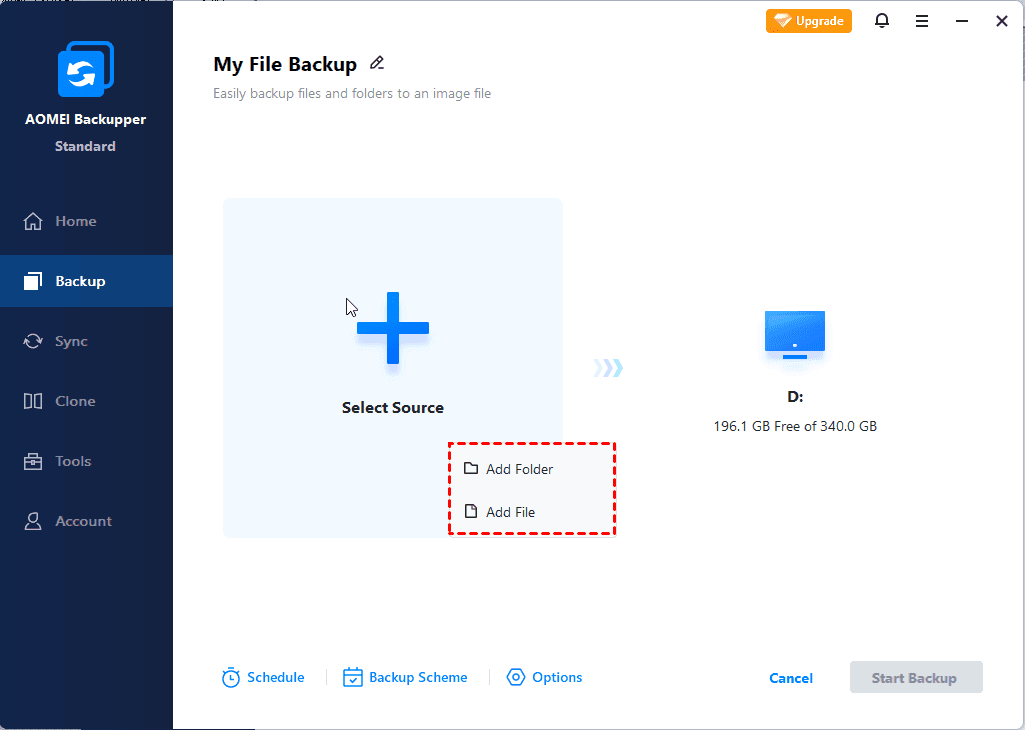
5.Click the folder shaped button, and then select the connected external disk to store file backup image.

6. To backup files to external hard drive automatically, click "Schedule" and select one or more settings.
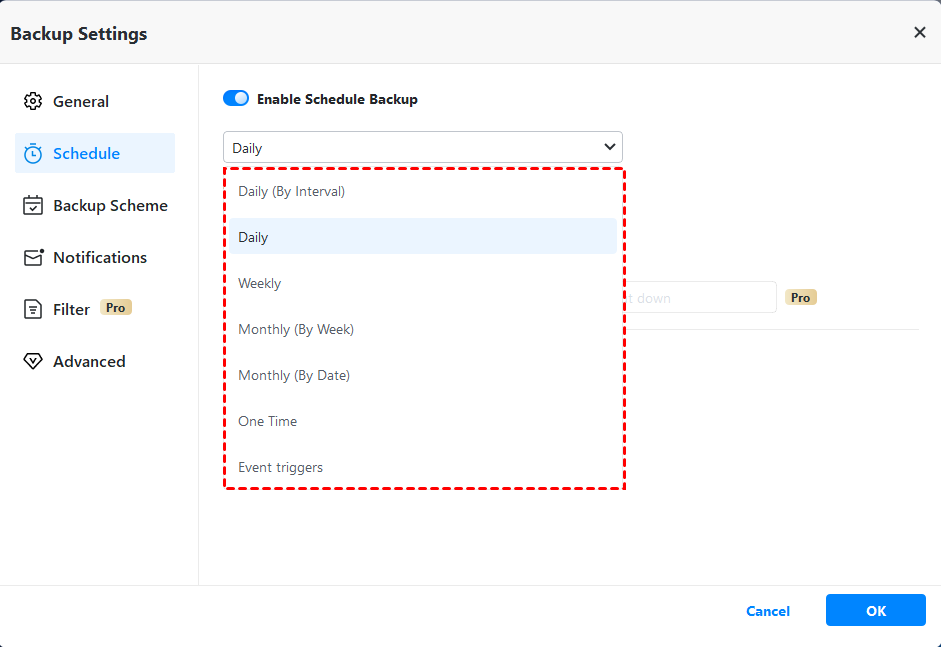
7. When you are ready, click "Start Backup" to back up files to the selected external hard drive. Then, click "Finish" when the operation has been completed successfully.

Tips:
-
If you want to backup files based on a specific event, such as system startup, you can use the "Event triggers" schedule mode (available in paid versions). For this backup schedule, you have 4 choices, including system startup, system shutdown, user logon, user logoff.
-
If you only want to backup changed files per day, you can combine general settings and advanced settings, such as daily incremental backup.
-
If you are troubled by low disk space, you can use "Scheme" feature. It has 5 choices according to your backup type and you can select the suitable one to delete backup files. Upgrade to higher editions to enjoy this feature.
Now, you can disconnect your external hard drive and put it in a safe location. If you replace your computer with a new one, you can also connect the external hard drive and restore files.
Method 2: backup file to external drive with File History
File History is a free built-in file backup tool, which was launched since Windows 8. This tool allows you to backup all the default and custom Libraries (including Public Folders), plus Contacts, Desktop and Favorites folders. And Windows add a new feature called "Add Folders" in Windows 10, which can help you backup specific folders.
To backup files with file history, use the steps below:
1. Connect the external drive to your computer, and ensure it can be detected.
2. Click "Start", type backup in the search box and select it.
3. Click "Add a drive" and select an external drive. Then, it will turn on the slide button under "Automatically back up my files" link.
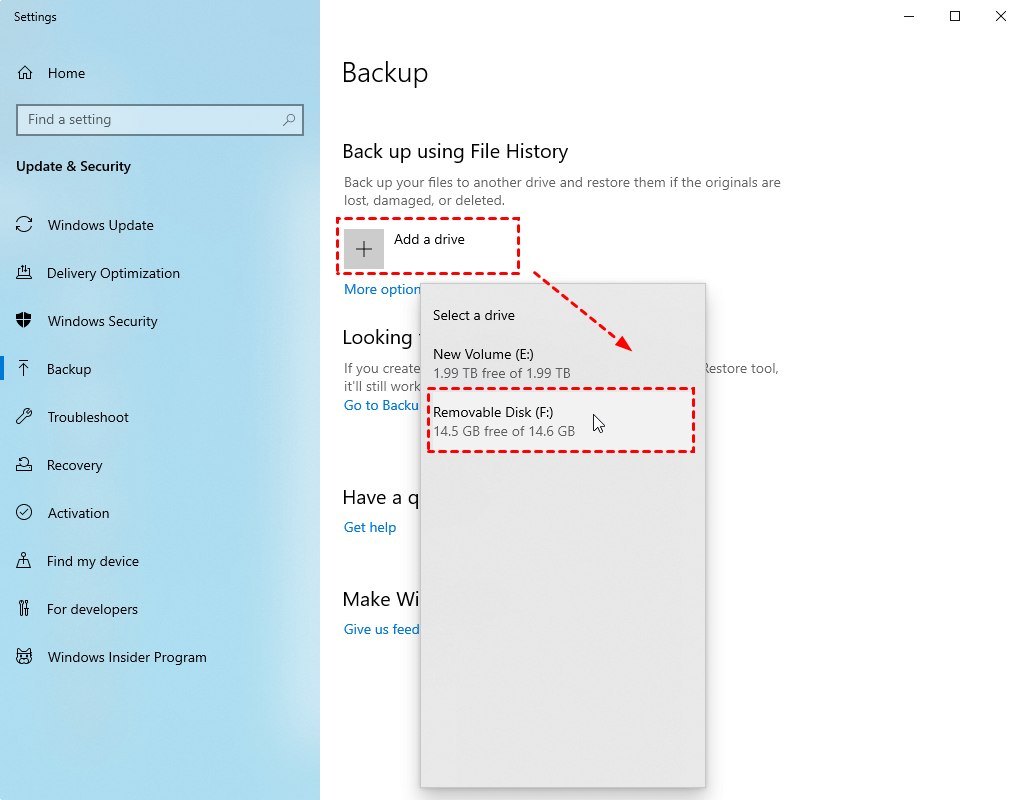
4. Click "More options" to set up backup settings. Scroll down to "Back up my files", "Keep my backups", "Exclude these folders" and select any setting you like. After that, go back to the top of backup options and click "Back up now" to backup your files immediately.
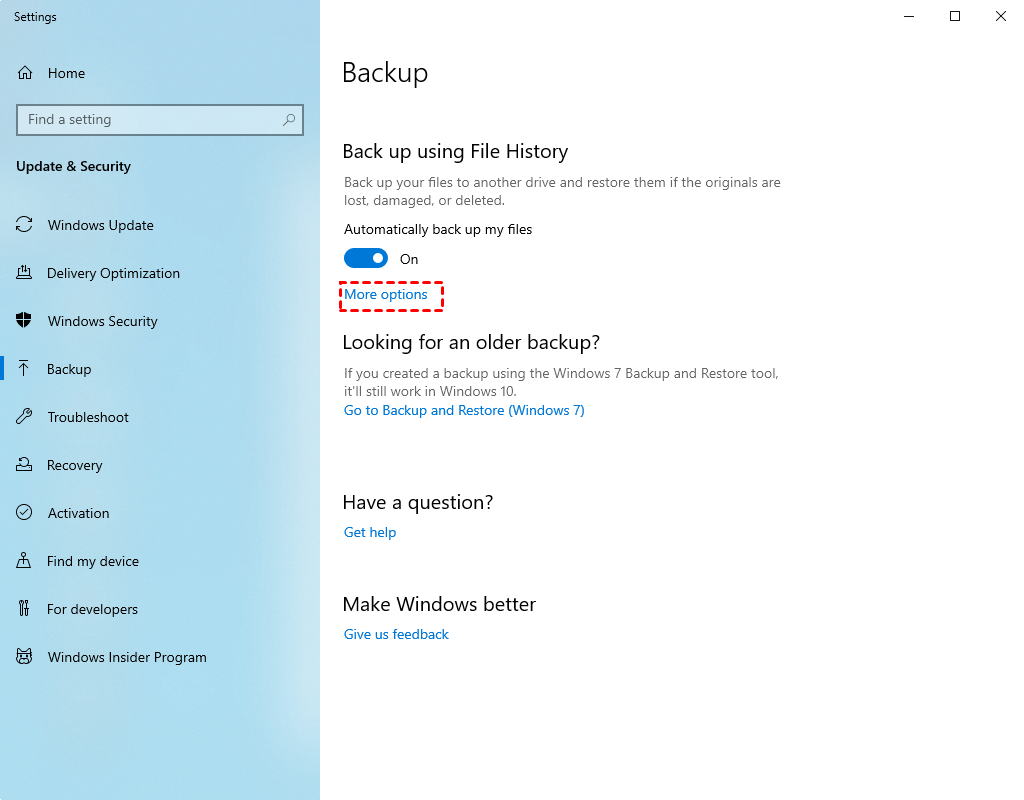
Method 3: backup files to external hard drive with Backup and Restore
In Windows 7, there is still a free backup software named "Backup and Restore", which allows you to backup individual files or entire system as you like. And this tool is kept in Windows 8 and later version.
To backup files with "Backup and Restore", follow the detailed steps below:
1. Connect your external hard disk, and then type backup in the search box and select it.
2. Then, click "Set up backup" to add the first backup task.
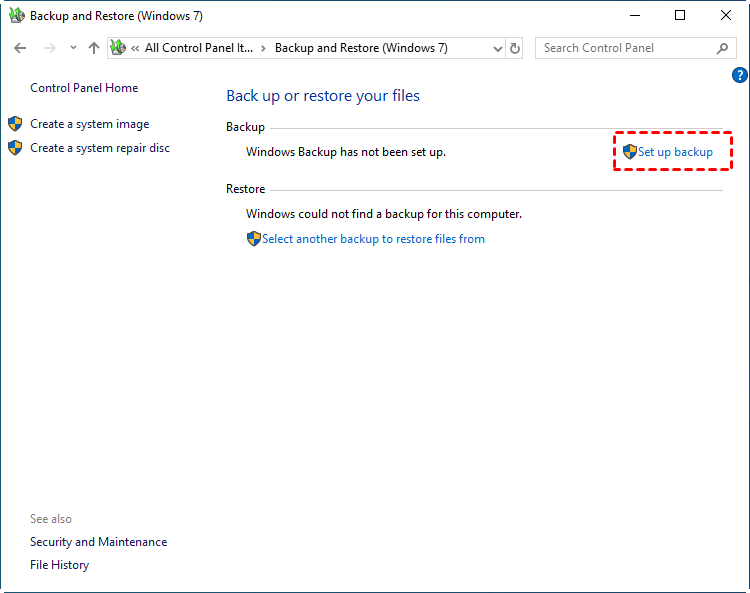
3. Select the connected external drive, and click Next.
4. Tick "Let me choose" and click Next.
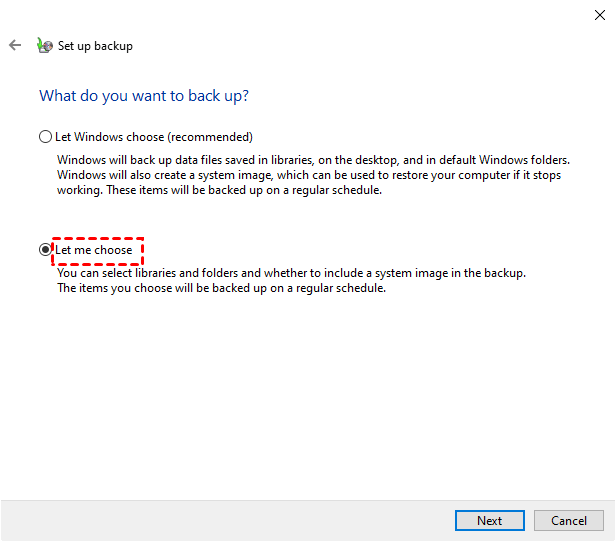
5. Check the folders you want to backup and click Next.
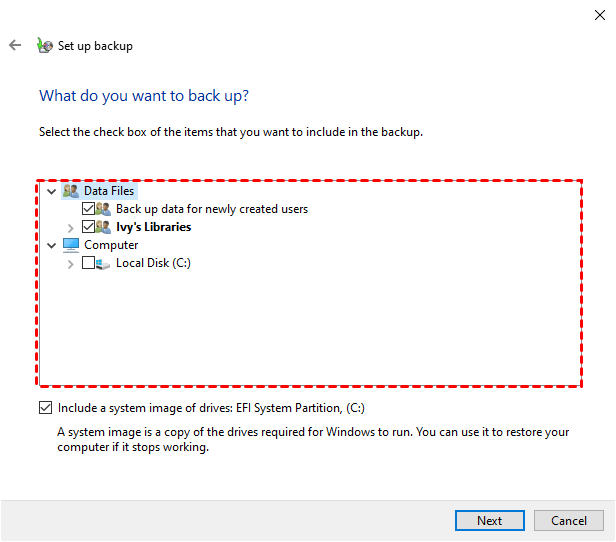
6. Click "Change schedule" to modify the backup settings. After that, click "Save settings and run backup" to start this task. You just need to wait patiently until the operation is completed 100%.
Note: The schedule backup is set to 7:00 PM every day. If you are not convenient at this time, you can change it to another time.
Tips on how to backup files to external hard drive in Windows 11:
If you are currently using Windows 11, the entrance to access File History and Backup and Restore may be a little difference. You have two ways in the following.
Way 1: Go to Control Panel > System and Security > File History or Backup and Restore (Windows 7).
Way 2: Go to Settings -> System -> Storage -> Advanced Storage options > Backup options, then scroll down to Back up using File History or Looking for an older backup.
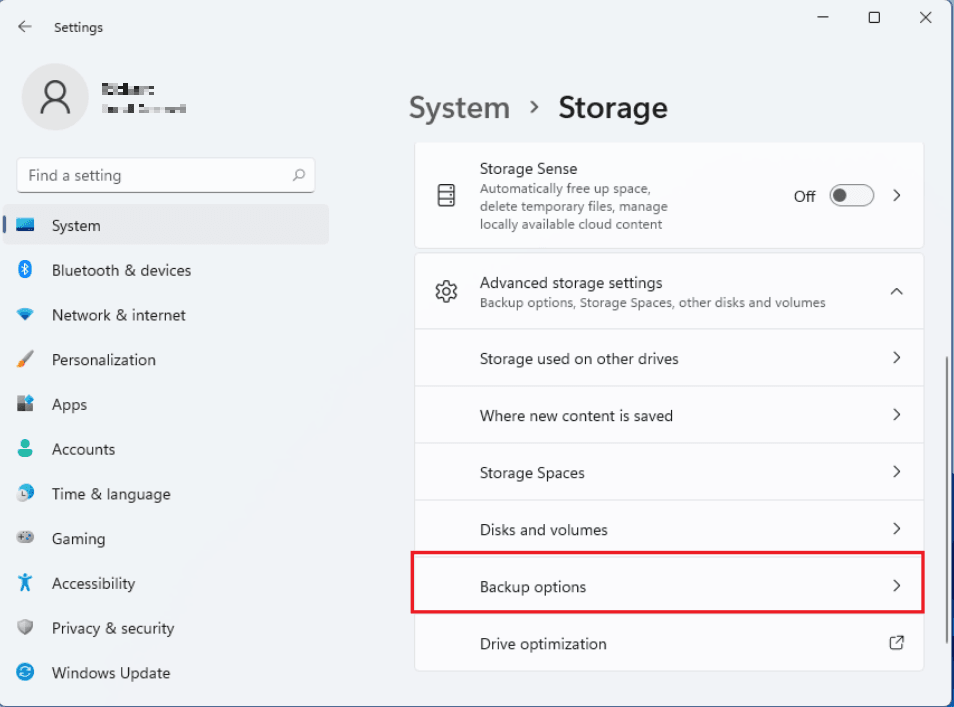
Written in the end
About how to backup files to external hard drive in Windows 10, 8, 7, you can use Windows built-in tool, such as, Backup and Restore, File History. Also, you can consider using a free but professional backup software like AOMEI Backupper Standard.
By comparison, backing your files with AOMEI Backupper is the easiest way. It has an intuitive interface that make users can easily and quickly understand the operation. And the backup process does not have any obstacle. Besides, it offers you more useful features, such as, daily backup, incremental backup, email notification, etc.
How to Tell if Your External Hard Drive Is Backing Up Recent Files
Source: https://www.ubackup.com/articles/backup-files-to-external-hard-drive-1203.html
0 Response to "How to Tell if Your External Hard Drive Is Backing Up Recent Files"
Post a Comment